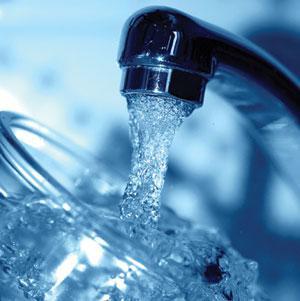 I spent some time this week at ACE12, the annual convention of the American Water Works Association. Walking the exhibit hall, I got a behind-the-scenes look at the normally invisible world of municipal water management.
I spent some time this week at ACE12, the annual convention of the American Water Works Association. Walking the exhibit hall, I got a behind-the-scenes look at the normally invisible world of municipal water management.
You probably have no idea what it takes to deliver water to your faucet, and what it takes to clean the waste water that leaves your home. The physics and chemistry needed to manage your water supply, while not complicated in theory, are nevertheless impressive, and expensive.
For water disinfection, municipalities have a number of options, including ultraviolet light and ozone. Overwhelmingly, most use either chlorine gas or bleach, which contains the chlorine molecule. Chlorine treatment is taken for granted now, but when it began, it was heralded as a major public health breakthrough. Life magazine, in fact, named water filtration and chlorination as ”probably the most significant public health advance of the millennium.” Even systems that choose ultraviolet or ozone still must treat their water with chlorine to protect it from contamination as it travels through pipes that carry it to your home.
Apparently, people have come to terms with shelling out good money for water. In 2011, according to the Beverage Marketing Corporation, U.S. consumers drank 9.1 billion gallons of the stuff – 29.2 gallons per person – and spent more than $11 billion for the privilege of doing so.
By comparison, the water delivered by pipes to your home is a bargain, but know that you’re going to be paying more for it. Like much of America’s infrastructure, the systems needed to carry water to your home are under duress. In 2005, and again in 2009, the American Society of Civil Engineers gave water infrastructure across the country a D-minus. The group noted that some water utilities in Alaska, Washington and North Dakota still use wooden pipes to carry water.
The ASCE says municipal pipe leaks cost the nation seven billion gallons of water each day—nearly 2 trillion of gallons of water, worth nearly $3 billion, every year. The EPA estimates 700 water mains break each day – nearly one every two minutes. A study by UCLA and Stanford found that more than 1.5 million people in Southern California get sick every year because of bacteria from polluted water released by broken pipes.
The EPA estimates that to achieve the needed infrastructure upgrades will cost between $750 billion and $1 trillion over the next two decades. The American Water Works Association has called for federal funding for half the current annual replacement costs, or about $15 billion each year. This seems reasonable; the U.S. government pays about 80 percent of the costs for replacing roads, bridges, and airports, and I’d say that water infrastructure is at least as important.
The new infrastructure will be smarter than its 19th- and 20th-century counterpart. Pipes can now be outfitted with sensors that signal when a break is imminent. Other types of sensors can tell when water quality is below standards and when a reservoir might be in danger of flooding.
Whatever happens, you can be sure of one thing: Our days of bargain water are numbered. We’re going to pay more as individuals, and as a society, for the water that enters and leaves our homes. Some of your money will be paid directly to your municipality or water utility, and some will be paid as taxes. As far as I’m concerned, it will be money well spent.

